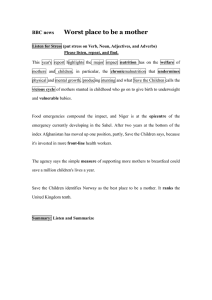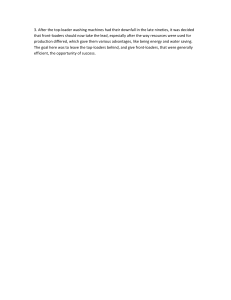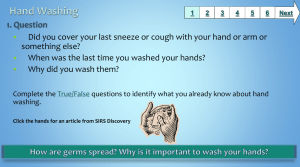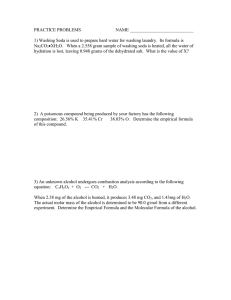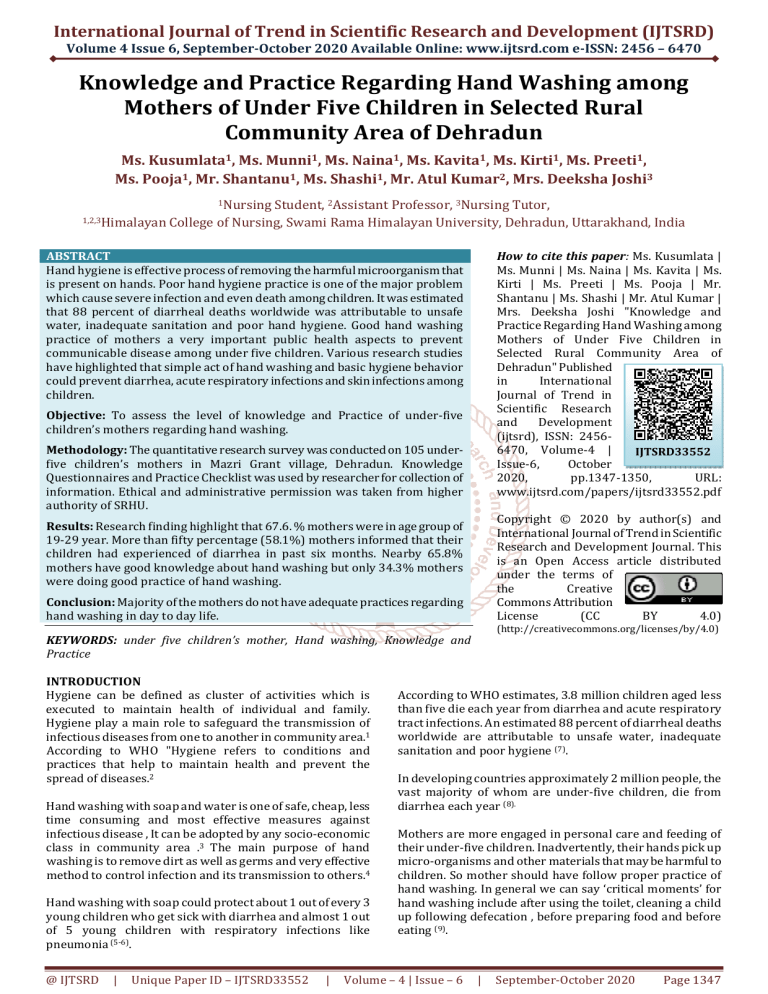
International Journal of Trend in Scientific Research and Development (IJTSRD)
Volume 4 Issue 6, September-October 2020 Available Online: www.ijtsrd.com e-ISSN: 2456 – 6470
Knowledge and Practice Regarding Hand Washing among
Mothers of Under Five Children in Selected Rural
Community Area of Dehradun
Ms. Kusumlata1, Ms. Munni1, Ms. Naina1, Ms. Kavita1, Ms. Kirti1, Ms. Preeti1,
Ms. Pooja1, Mr. Shantanu1, Ms. Shashi1, Mr. Atul Kumar2, Mrs. Deeksha Joshi3
1Nursing
Student, 2Assistant Professor, 3Nursing Tutor,
1,2,3Himalayan College of Nursing, Swami Rama Himalayan University, Dehradun, Uttarakhand, India
How to cite this paper: Ms. Kusumlata |
Ms. Munni | Ms. Naina | Ms. Kavita | Ms.
Kirti | Ms. Preeti | Ms. Pooja | Mr.
Shantanu | Ms. Shashi | Mr. Atul Kumar |
Mrs. Deeksha Joshi "Knowledge and
Practice Regarding Hand Washing among
Mothers of Under Five Children in
Selected Rural Community Area of
Dehradun" Published
in
International
Journal of Trend in
Scientific Research
and
Development
(ijtsrd), ISSN: 24566470, Volume-4 |
IJTSRD33552
Issue-6,
October
2020,
pp.1347-1350,
URL:
www.ijtsrd.com/papers/ijtsrd33552.pdf
ABSTRACT
Hand hygiene is effective process of removing the harmful microorganism that
is present on hands. Poor hand hygiene practice is one of the major problem
which cause severe infection and even death among children. It was estimated
that 88 percent of diarrheal deaths worldwide was attributable to unsafe
water, inadequate sanitation and poor hand hygiene. Good hand washing
practice of mothers a very important public health aspects to prevent
communicable disease among under five children. Various research studies
have highlighted that simple act of hand washing and basic hygiene behavior
could prevent diarrhea, acute respiratory infections and skin infections among
children.
Objective: To assess the level of knowledge and Practice of under-five
children’s mothers regarding hand washing.
Methodology: The quantitative research survey was conducted on 105 underfive children’s mothers in Mazri Grant village, Dehradun. Knowledge
Questionnaires and Practice Checklist was used by researcher for collection of
information. Ethical and administrative permission was taken from higher
authority of SRHU.
Copyright © 2020 by author(s) and
International Journal of Trend in Scientific
Research and Development Journal. This
is an Open Access article distributed
under the terms of
the
Creative
Commons Attribution
License
(CC
BY
4.0)
Results: Research finding highlight that 67.6. % mothers were in age group of
19-29 year. More than fifty percentage (58.1%) mothers informed that their
children had experienced of diarrhea in past six months. Nearby 65.8%
mothers have good knowledge about hand washing but only 34.3% mothers
were doing good practice of hand washing.
Conclusion: Majority of the mothers do not have adequate practices regarding
hand washing in day to day life.
(http://creativecommons.org/licenses/by/4.0)
KEYWORDS: under five children’s mother, Hand washing, Knowledge and
Practice
INTRODUCTION
Hygiene can be defined as cluster of activities which is
executed to maintain health of individual and family.
Hygiene play a main role to safeguard the transmission of
infectious diseases from one to another in community area.1
According to WHO "Hygiene refers to conditions and
practices that help to maintain health and prevent the
spread of diseases.2
Hand washing with soap and water is one of safe, cheap, less
time consuming and most effective measures against
infectious disease , It can be adopted by any socio-economic
class in community area .3 The main purpose of hand
washing is to remove dirt as well as germs and very effective
method to control infection and its transmission to others.4
Hand washing with soap could protect about 1 out of every 3
young children who get sick with diarrhea and almost 1 out
of 5 young children with respiratory infections like
pneumonia (5-6).
@ IJTSRD
|
Unique Paper ID – IJTSRD33552
|
According to WHO estimates, 3.8 million children aged less
than five die each year from diarrhea and acute respiratory
tract infections. An estimated 88 percent of diarrheal deaths
worldwide are attributable to unsafe water, inadequate
sanitation and poor hygiene (7).
In developing countries approximately 2 million people, the
vast majority of whom are under-five children, die from
diarrhea each year (8).
Mothers are more engaged in personal care and feeding of
their under-five children. Inadvertently, their hands pick up
micro-organisms and other materials that may be harmful to
children. So mother should have follow proper practice of
hand washing. In general we can say ‘critical moments’ for
hand washing include after using the toilet, cleaning a child
up following defecation , before preparing food and before
eating (9).
Volume – 4 | Issue – 6
|
September-October 2020
Page 1347
International Journal of Trend in Scientific Research and Development (IJTSRD) @ www.ijtsrd.com eISSN: 2456-6470
Hand washing, if regularly and properly practiced by under 5
children’s mothers, it will go a long way in reducing the
prevalence of infectious diseases, hospital admissions due to
these diseases and also mortality among the under 5 years
old children, thereby making them grow well and healthy(10) .
In 2006 study was conducted in Idumebo (Nigeria) a rural
community found that 30% of mothers administer
complimentary feeds to their infants without proper hand
washing (11).
Effective hand washing involves the brief rubbing together of
all surfaces of lathered hands, followed by rinsing under a
stream of water. This action suspends microorganisms and
mechanically removes them by rinsing with water thereby
reducing the number of microbes on the hands in most
situations (12). .
Globally, hand washing day is observed every year on 15th
October. In today’s period hand washing become a very
crucial part of or habit of every one’s life no matter whether
he or she ordinary person or professional. (13)
Understanding usual hand washing is an important baseline
assessment for any programme intended to improve
sanitation. Keeping this in view present study was taken up
to study the knowledge attitude practices relating to hand
washing of mothers. Thus, there is an important link
between poor hand washing practices of mothers and the
morbidity of children less than 5 years of age especially
those living in rural communities.
OBJECTIVES:
To assess the level of knowledge of under-five children’s
mothers regarding hand washing.
To assess the level of practice of under-five children’s
mothers regarding hand washing.
MATERIAL AND METHODS:
The present descriptive survey research study was carried
out among 105 under five children’s mothers which were
selected by purpose sampling technique in selected
community area of Dehradun . Research variable include in
study was Knowledge and practice regarding hand washing.
The tools used for study were structured demographic
Performa, Knowledge Questionnaires and Self Reported
Practice Checklist . Research tools was validated from five
experts in nursing For pretest questionnaire were
administered to 5 under five children mother’s. The
reliability for knowledge questionnaire was obtained by split
half method (r=0.85) and practice test retest method which
was found to be reliable at 0.96 for practice. Ethical
permission was obtained from the concerned institutional
authorities and prior informed consent was taken from the
study participants. The research data was collected and
enter in MS Excel. Frequency and percentages distribution
were used to analyses categorical variables of study.
RESULTS:
Table No. 1: Demographic characteristics of under five children’s mother by Frequency and Percentage. n= 105
S. No.
Demographic characteristics
Frequency (f) Percentage (%)
Mother age (in Year)
1.
a)20-29
71
67.6
b) 30-40
34
32.4
Educational Status of Mother
a)No formal education
4
3.8
2.
b)Primary
23
21.9
c)Secondary
44
41.9
d) Graduate
34
32.4
Occupation
3.
Non working
89
84.8
Working
16
15.2
Type of family
4.
Nuclear
49
46.7
Joint
56
53.3
Number of under five children in family
5.
1
87
82.9
2
18
17.1
Source of water
6.
Tank
3
2.9
Tap water
102
97.1
Source of information
Family members
7
6.7
7.
Mass media
73
69.5
Health worker
25
23.8
Does your child going to school/ Anganwadi
8.
a)Yes
54
51.4
b) No
51
48.6
Diarrhea incidence in past 6 months
9.
a)Yes
61
58.1
b) No
44
41.9
@ IJTSRD
|
Unique Paper ID – IJTSRD33552
|
Volume – 4 | Issue – 6
|
September-October 2020
Page 1348
International Journal of Trend in Scientific Research and Development (IJTSRD) @ www.ijtsrd.com eISSN: 2456-6470
Most (67.6%) of mothers was in age of 20-29 years, 41.9% mothers were secondary educated , majority of the mothers (84.8%)
were non-working, Nearly 43.8% mothers were living in joint family and most of the mothers (82.9%) had only one child in
family, Majority of mothers (97.1%) used tap water in their houses, Nearly three fourth (69.5%) got some basic knowledge
regarding hand washing from mass media. Nearly half (51.4%) children were going to School/ Anganwadi, Most of mothers
(58.1%) informed that their children had expose of diarrhea in past six months.
Table No. 2 knowledge score of mothers regarding hand washing. n= 105
Level of Knowledge Knowledge Score Frequency (f) Percentage (%)
Poor
<8
1
0.9
Average
9-16
35
33.3
Good
17-24
69
65.8
Majority (65.8%) of mothers had good knowledge score and nearby 33.3% of mothers had average knowledge score regarding
hand washing.
Table No. 3 Mothers Practice score regarding hand washing n=105
Level of Practice Practice score Frequency (f) Percentage (%)
Average
7-12
69
65.7
Good
13-18
36
34.3
Most of (65.7%) mothers had average practice and only 34.3% of mothers had good practice regarding hand washing.
DISCUSSION:
Section- A: Description of demographic profile of under
five children mothers:
The study findings highlighted that nearly three fifth
(67.6%) mothers belong to 19-40 years of age group. 41.9%
mothers were secondary educated, maximum mothers
(84.4%) were non-working, 53.3% children belong joint
family, Most of mother (69.5%) had information about
importance of hand washing through mass media . 58.1%
mother inform that within 6 month duration their child was
suffer from diarrhea. Findings were reliable with cross
sectional study done by Mr. Rajiv Kumar Gupta et all (2018)
“Hand hygiene: knowledge, attitude and practices among
mothers”. The result of study revealed that 75.15% of the
mothers belonged to 20-29 year age group, 38.79% of the
respondents were educated up to secondary level (14).
Section B: Level of knowledge of mothers regarding
hand washing
On interpretation of data; it is revealed that nearly (65.8%)
of mothers had good knowledge score regarding hand
washing. 33.3% of mothers had average knowledge score.
This research finding was supported by cross-sectional
study done by Mr. Pravin N Yerpude et all (2014) “ Hand
Washing Practices among Mothers in an Urban Slum Area
“The finding of study highlight that most of (71.49%)
mothers have good knowledge and stated that hand washing
was important in prevention of some communicable
diseases .
Section C: Level of practice of mothers regarding hand
washing
On based of analysis researcher found that less than half
(34.3%) mother was doing correct hand washing practice
and 65.7% mothers were not proper practice hand washing
during care of children . This finding was supported by Mr. S
S Datta et all (2011) “Knowledge and practice of hand
washing among mothers of under five children in rural
coastal South India, The finding of this study highlight that
mother not follow correct practice of hand washing (16) .
@ IJTSRD
|
Unique Paper ID – IJTSRD33552
|
LIMITATIONS:
Study design was confined to survey method only.
Sample Size was very less (105)
Researchers were not provide any intervention for
improving knowledge and practice of under five
children’s mothers
CONCLUSION:
The study finding shows that there was gap between
knowledge and practice of mothers regarding hand washing .
The researchers reiterates the need to spread importance of
proper and regular hand washing through proper health
education.
RECOMMENDATION :- As the research study indicate the
mothers were not doing proper practice of hand washing
during care of child so the health workers should be create
awareness activities until all mothers were start proper
practice of hand washing.
REFERENCES:
[1] https://en.m.wikipedia.org/wiki/Hygiene
[2]
www.who.int › hygiene
[3]
LeTexier,
R.
Infection
Control
Today.
http://www.infectioncontroltoday.com/articles/
(accessed on 12 May 2015)
[4]
https://en.m.wikipedia.org/wiki/Hand_washing
[5]
Ejemot RI, Ehiri JE, Meremikwu MM, Critchley JA.
Hand washing for preventing diarrhoea. Cochrane
Database Syst Rev. 2008; 1: CD004265.
[6]
Aiello AE, Coulborn RM, Perez V, Larson EL. Effect of
hand hygiene on infectious disease risk in the
community setting: a meta-analysis. Am J Public
Health. 2008; 98(8):1372-81.
[7]
Murray CJ, Lopez AD. Global mortality, disability, and
the contribution of risk factors: Global Burden of
Disease Study. Lancet 1997; 349:1436–1442.
Volume – 4 | Issue – 6
|
September-October 2020
Page 1349
International Journal of Trend in Scientific Research and Development (IJTSRD) @ www.ijtsrd.com eISSN: 2456-6470
[8]
Girma R. Wondwossen B, Bishaw D, & Tefera B.
(2008). Environmental determinants of diarrhea
among under-five children in nekemte town, western
ethiopia. Ethiopian Journal of Health Science,
18(2):39-45.
[9]
Water Supply and Sanitation Collaborative Council.
Global
hand
washing
day.
http://www.wsscc.org/wash-advocacy/campaignsevents/global-handwashing-day (accessed on 8 May
2015).
[10]
Curtis V, Cairncross S. Effects of washing hands with
soap on diarrhea risk in the community: a systematic
review. Lancet Infect Dis. 2003; 3:275-81.
[11]
Abah, S. O.; Ilevbare, U.; Asogun, A. D. Infant feeding
practices in a rural Nigerian community. Journal of
Applied and Basic Sciences 2006. 4(1) 25-31.
[12]
Centers for Diseases Control and Prevention. Hand
washing:
clean
hands
save
lives.
@ IJTSRD
|
Unique Paper ID – IJTSRD33552
|
http/www.cdc.gov/handwashing/. (Accessed on 16
April 2015).
[13]
Hand Washing |National Health Portal of India..
www.nhp.gov.in
[14]
Rajiv Kumar Gupta, Parveen Singh, Renu Rani etc,
Hand hygiene: knowledge, attitude and practices
among mothers of under 5 children attending a
tertiary
care
hospital
in
North
India.
http://www.ijcmph.com 2018 Mar;5(3):1116-1121
[15]
Mr. Pravin N Yerpude Keerti S Jogdand, Nashira A
Sumra “Hand Washing Practices among Mothers in an
Urban Slum Area ,www.ijhsr.org , Vol.4; Issue: 10;
October 2014
[16]
Knowledge and practice of hand washing among
mothers of under five children in rural coastal South
India Datta SS1, Singh Z2, Boratne AV3, Senthilvel V4,
Bazroy J5 and Dimri D6 . International Journal of
Medicine and Public Health, 2011
Volume – 4 | Issue – 6
|
September-October 2020
Page 1350

